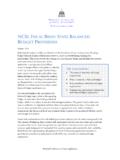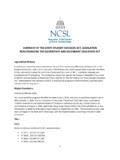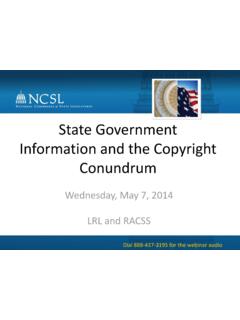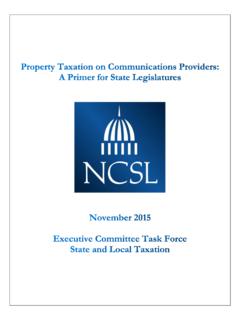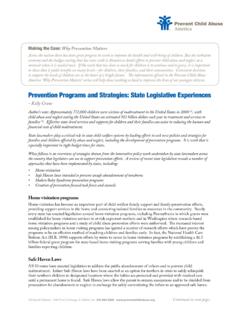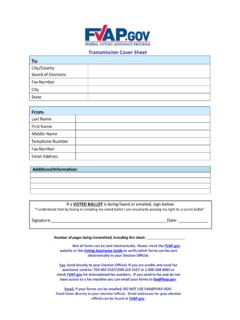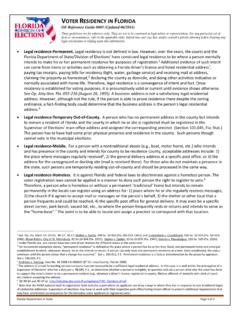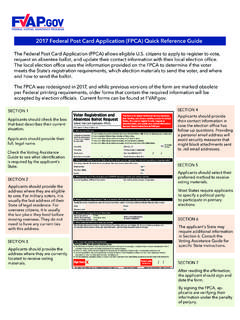Transcription of Department of Defense – State Liaison Office (DSLO)
1 Department of Defense State Liaison Office (DSLO). Purpose Since many issues surrounding quality of life and family well-being can only be addressed by states , the Department of Defense (DoD) started the USA4 Military Families initiative, worked through the DoD- State Liaison Office (DSLO), to engage State policymakers, not-for-profit associations, concerned business interests, and other State leaders about the needs of military members and their families. By developing State /military partnerships, the DoD seeks to work with states to remove unnecessary barriers and significantly improve the quality of life for military families. What we do The DSLO has 10 Liaisons across the country working with the many State leaders who are concerned for the welfare of the Active Duty, Guard, and Reserve Service members and their families living within their borders. We broadly educate State leaders on the 10 key issues, and as this education process proceeds, build relationships with interested State leaders.
2 If one of these leaders (normally members of the legislature) wants to tackle an issue, we can provide assistance in the form of identifying best practice' legislation from other states and providing testimony as it is requested. Initiatives Currently, efforts are being focused on the following 10 key issues (as approved by the Under Secretary of Defense for Personnel &Readiness) which promote the well-being of our Service members and their families (detailed information at ): 1. Facilitate service members receiving licensure and academic credit for military education, training and experience. 2. Facilitate military spouse career transition through licensure portability and eligibility for unemployment compensation. 3. Support development of Veterans Treatment Courts open to eligible veterans and service members throughout the State . 4. Increase access to quality, affordable child care by military families.
3 5. Promote consumer protections and enforcement of the predatory lending regulation. 6. Allow Service members to retain their earned priority for receiving Medicaid home and community care waivers. 7. Improve absentee voting for military members and their families. 8. Waive required waiting time to establish residency for separating Service members to obtain in- State tuition rates. 9. Assign an identifier for military children in education data systems. 10. Create State -wide MoUs between the DoD and the State child welfare agency to standardize relationships. Track record The USA4 Military Families initiative has been very successful and much progress has been made. Over the past couple of years, states have addressed several key quality of life issues, to include the impact of frequent school transitions experienced by military children, the loss income by military spouses as a result of military moves, and the enforcement of the Congressionally mandated DoD predatory lending regulation.
4 In this regard, 43 states have joined the Interstate Compact on Educational Opportunity for Military Children, 45 states now provide eligibility for unemployment compensation to military spouses, and 36 states can enforce the DoD predatory lending regulation. Key Personnel and Readiness Issues Supporting Service Members and Families (For 2013). 1. Facilitate Service members receiving licensure and academic credit for military education, training and experience: By not receiving credit, separating Service members may be held back from finding employment or finishing a degree. states can establish policies that ensure separating Service members do not have to repeat requirements completed during their military career to obtain academic credit or an occupational license. 2. Facilitate military spouse transition through licensure portability and eligibility for unemployment compensation: Mandatory military moves require spouses to leave employment and start again in a State with new licensing requirements.
5 states can help by expediting licensing through endorsement, temporary licensure and streamlined processes. states should also recognize that these mandatory job separations should afford military spouses eligibility for unemployment compensation. 3. Provide authority for establishing Veteran Treatment Courts (VTCs): One in five veterans suffers from Acute Stress Disorder (ASD), Post Traumatic Stress Disorder (PTSD), Traumatic Brain Injury (TBI), substance abuse, or other behavioral health problems. These problems can result in homelessness, family stress and/or disintegration, and instances of criminal behavior. states can help by authorizing VTCs to provide opportunities for rehabilitation (instead of incarceration) for veterans and service members experiencing behavioral health problems. 4. Increase access to quality childcare for military families: Demand for child care continues to out-pace capacity.
6 states can assist in enhancing available capacity by integrating DoD standards on inspections and background checks into their Quality Rating and Improvement Systems (QRIS) for child care programs. 5. Promote consumer protections and enforcement of the predatory lending regulation: Military consumers are vulnerable to unscrupulous practices. Some lending practices create a cycle of debt, thus detracting from financial wellbeing and military readiness. states can help by working with the military community on consumer concerns and by fully enforcing the DoD Regulation on payday, vehicle title, and refund anticipation loans. 6. Allow Service members to retain their earned priority for receiving Medicaid home and community care waivers: Because states frequently have long waiting lists, members face large gaps in service every time they transfer across State lines. Allowing Service members to enroll their exceptional family member in the State they designate as their legal residence ( where they pay taxes, vote, etc.)
7 Can stabilize their request for support. 7. Improve absentee voting for military members and their families: Citizens need assurance their vote will be counted. states can approve the Uniform Military and Overseas Voter Act (UMOVA) which supports the flexible processes for absentee voters in the areas recommended by the Federal Voting Assistance Program (FVAP) Office . 8. Waive required waiting time to establish residency for separating Service members so they can obtain in- State tuition rates: The Post 9/11 GI Bill covers only in- State tuition and eligible fees, which means that veterans who settle in a State as a nonresident pay the difference between the resident and non-resident charges. states can waive residency requirements to allow separating Service members to receive in- State tuition rates until they qualify for residency. 9. Assign an identifier for military children in education data systems: Although military children experience life challenges as a result of their parents' military service, there is no method of tracking their attendance and academic progress in public schools.
8 states can assist DoD in developing policy and military child education initiatives, by identifying military children and providing data on their educational outcomes. 10. Create State -wide MoUs between the DoD and the State child welfare agency to standardize relationships among local courts, agencies and military communities: DoD installations currently develop MoUs with counties which can leave gaps in coverage and inconsistencies in managing care for children in protective custody and foster care. Statewide MOUs between DoD (on behalf of the military communities) and the State child welfare agency (on behalf of local child protective services and other State and local agencies) can support improved continuity and child safety. Staff point of contact: Ed Kringer, 571-372-5321.
